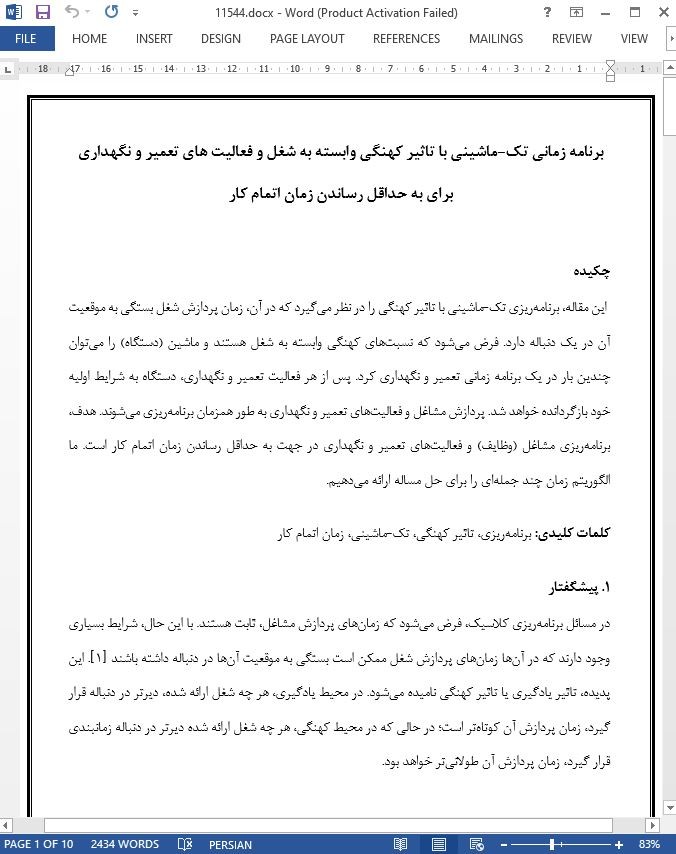
برنامه زمانی تک-ماشینی با تاثیر کهنگی وابسته به شغل و فعالیت های تعمیر و نگهداری
چکیده
این مقاله، برنامهریزی تک-ماشینی با تاثیر کهنگی را در نظر میگیرد که در آن، زمان پردازش شغل بستگی به موقعیت آن در یک دنباله دارد. فرض میشود که نسبتهای کهنگی وابسته به شغل هستند و ماشین (دستگاه) را میتوان چندین بار در یک برنامه زمانی تعمیر و نگهداری کرد. پس از هر فعالیت تعمیر و نگهداری، دستگاه به شرایط اولیه خود بازگردانده خواهد شد. پردازش مشاغل و فعالیتهای تعمیر و نگهداری به طور همزمان برنامهریزی میشوند. هدف، برنامهریزی مشاغل (وظایف) و فعالیتهای تعمیر و نگهداری در جهت به حداقل رساندن زمان اتمام کار است. ما الگوریتم زمان چند جملهای را برای حل مساله ارائه میدهیم.
1. پیشگفتار
در مسائل برنامهریزی کلاسیک، فرض میشود که زمانهای پردازش مشاغل، ثابت هستند. با این حال، شرایط بسیاری وجود دارند که در آنها زمانهای پردازش شغل ممکن است بستگی به موقعیت آنها در دنباله داشته باشند [1]. این پدیده، تاثیر یادگیری یا تاثیر کهنگی نامیده میشود. در محیط یادگیری، هر چه شغل ارائه شده، دیرتر در دنباله قرار گیرد، زمان پردازش آن کوتاهتر است؛ در حالی که در محیط کهنگی، هر چه شغل ارائه شده دیرتر در دنباله زمانبندی قرار گیرد، زمان پردازش آن طولانیتر خواهد بود.
Abstract
This paper considers single machine scheduling with an aging effect in which the processing time of a job depends on its position in a sequence. It is assumed that aging ratios are job-dependent and machine can be maintained some times in a schedule. After a maintenance activity, machine will be restored to its initial condition. The processing of jobs and the maintenance activities of machine are scheduled simultaneously. The objective is to schedule the jobs and the maintenance activities, so as to minimize the makespan. We provide a polynomial time algorithm to solve the problem.
1. Introduction
In the classical scheduling problems it is assumed that the processing times of jobs are constant. However, there are many situations where the processing times of the job may be dependent on their positions in the sequence [1]. This phenomenon is called learning effect or aging effect. In a learning environment, the later a given job is scheduled in the sequence, the shorter its processing time; while in an aging environment, the later a given job is scheduled in the sequence, the longer its processing time.
چکیده
1. پیشگفتار
2. بیان مساله
3. نتایج اصلی
4. حالت خاص
5. نتیجهگیریها
Abstract
1. Introduction
2. Problem statement
3. Main results
4. Special case
5. Conclusions
- ترجمه فارسی مقاله با فرمت ورد (word) با قابلیت ویرایش، بدون آرم سایت ای ترجمه
- ترجمه فارسی مقاله با فرمت pdf، بدون آرم سایت ای ترجمه

